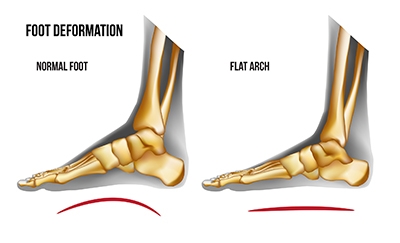Flat Feet Treatment in Beverly Hills
What are flat feet?
“Flat feet” is a loose term that defines the lack of height of the inner arch as compared to the normal arch. There are varying degrees of how flat an arch can become. Not all flat feet are created equal. Some low arches are flexible, meaning that the arch can be manipulated and flexed, while others are rigid and static. Not all people with flat feet have pain or difficulty with activity. A child with flat feet will not necessarily develop pain or problems in the future. Not all flat feet need treatment.

What is pronation?
Pronation is a verb that describes the action of the foot bones and the arch while walking. During normal walking, the foot bones will rotate and move about their joints, going from a higher arch to a lower arch. This motion is called pronation. Patients that have too much motion at these joints during walking have over pronation. Over pronation can be painful and lead to foot fatigue and ankle, knee, and hip problems.
The major players acting on the arch of the foot that determine its height and function are:
Subtalar Joint: the joint between the ankle bone and the heel bone
Talo-Navicular Joint: the joint between the ankle bone and the inside foot bone
Calcaneocuboid Joint: the joint between the heel bone and the outside foot bone
Posterior Tibial Tendon: the tendon on the inside of the arch
It’s All Connected…
The heel bone should normally be perpendicular to the ground. Depending on the severity of the flat foot, the heel bone will be tilted away from the other foot (everted) when looking from behind the foot. This mal position of the heel bone will change the relationship between it and the ankle bone. The ankle bone will then react to this poor position by rotating off the foot bone (navicular) in front of it. This rotation will contribute to a collapsing arch. As the arch collapses, the remaining long bones of the foot and toes will point away from the other foot.
What are the symptoms of adult flat feet?
Patients will describe the symptoms of a flat foot in many different ways and in different areas of the foot and ankle depending on the severity of the deformity, length of time with the problem, and activity level.
Arch Pain
Arch Fatigue
Tendon Pain (Posterior Tibial Tendonitis)
Out-towing of the Feet
Pain at the Outer Portion of the Ankle (Sinus Tarsi Syndrome) (Impingement)
The Heel Rotated Outward
Loss of Arch Height
Heel Pain (Plantar Fasciitis)
Bunion
Foot Arthritis
Knee Pain
What are the causes of adult flat feet?
Ultimately it is our genetics that will dictate how our bones and the relationship between them will be once we are older. Some may be born with a flatter foot type, while others will see their arch lowering over time. Some causes of an adult flat foot are from internal anatomical reasons, while others are external and environmental causes.
Obesity
Ligamentous Laxity
Equinus (Tight or Short Achilles Tendon)
Forefoot Varus (a tilt of the ball of the foot inwards)
Excessive motion at the Subtalar Joint
Coalition (joints that are improperly connected at birth)
Mal-alignment between the rearfoot and midfoot joints
Posterior Tibial Tendinosis / Posterior Tibial Tendon Dysfunction
Overuse
Sports Injuries
Poor Shoes
Heel Fractures
How is adult flat foot diagnosed?
Diagnosis is simply achieved by the clinical examination and x-rays of the patient. Dr. Soomekh will listen to the patient’s complaints, symptoms, and goals. The examination involves a hands-on analysis of the patient’s foot and evaluation of the relationship of the foot and ankle joints with one another. An analysis of the patient’s gait will be carefully examined. It will be important to determine both the root cause of the flat foot and the contributing factors. Digital radiographs (x-rays) of the foot and ankle will be obtained in the office and reviewed with the patient. A specialized CT scan of the foot may be obtained to evaluate the joints and their relationships in 3D for proper diagnosis and treatment. The positions of the bones and joints evaluated on the x-rays help to determine the severity of the deformity and any associated deformities.
How are adult flat feet treated?
CONSERVATIVE TREATMENT:
In the early and middle stages of a flat foot deformity, treatment will begin conservatively. Treatment at this stage will attempt to control the excessive motion of the joints involved and diminish the fatigue and pain, to lead to increased function and activity.
Functional Custom Molded Orthotics
Braces
Physical Therapy
A period of rest from activity
SURGICAL TREATMENT:
In severe cases of flat feet that cause chronic pain and fatigue, that have failed conservative treatments, surgical reconstruction of the arch and the position of the heel bone may be needed.
Reconstruction of a flat foot is a complex task that requires proper diagnosis of the cause of the flat foot, the contributing factors, and the position of the foot and ankle joints and their relationships to each other. It requires the surgeon to perform a thorough examination of the patient along with imaging through x-rays and CT scans as needed.
There are many different ways to reconstruct a flat foot. Dr. Soomekh will choose the correct procedure or multiple procedures depending on the individual patient and their goals. There is no one procedure for all patients. Surgical planning is paramount.
Here are some examples of surgical procedures that can be performed:
Posterior Tibial Tendon Repair
Tendon Transfers
Achilles Tendon Lengthening
Gastroc Recession
Subtalar Arthroereisis (Implant Stop)
Calcaneal Osteotomy (Heel Bone Repositioning)
Evans Procedure
Calcaneal Slide
Talonavicular fusion
Medial Column Fusion
Subtalar Fusion
Triple Arthrodesis
Dr. Soomekh has perfected and reinvented these surgical procedures and techniques for treatment of Flat Feet and is recognized by his peers as one of the foot and ankle specialists and surgeons in Beverly Hills and the Los Angeles area.












